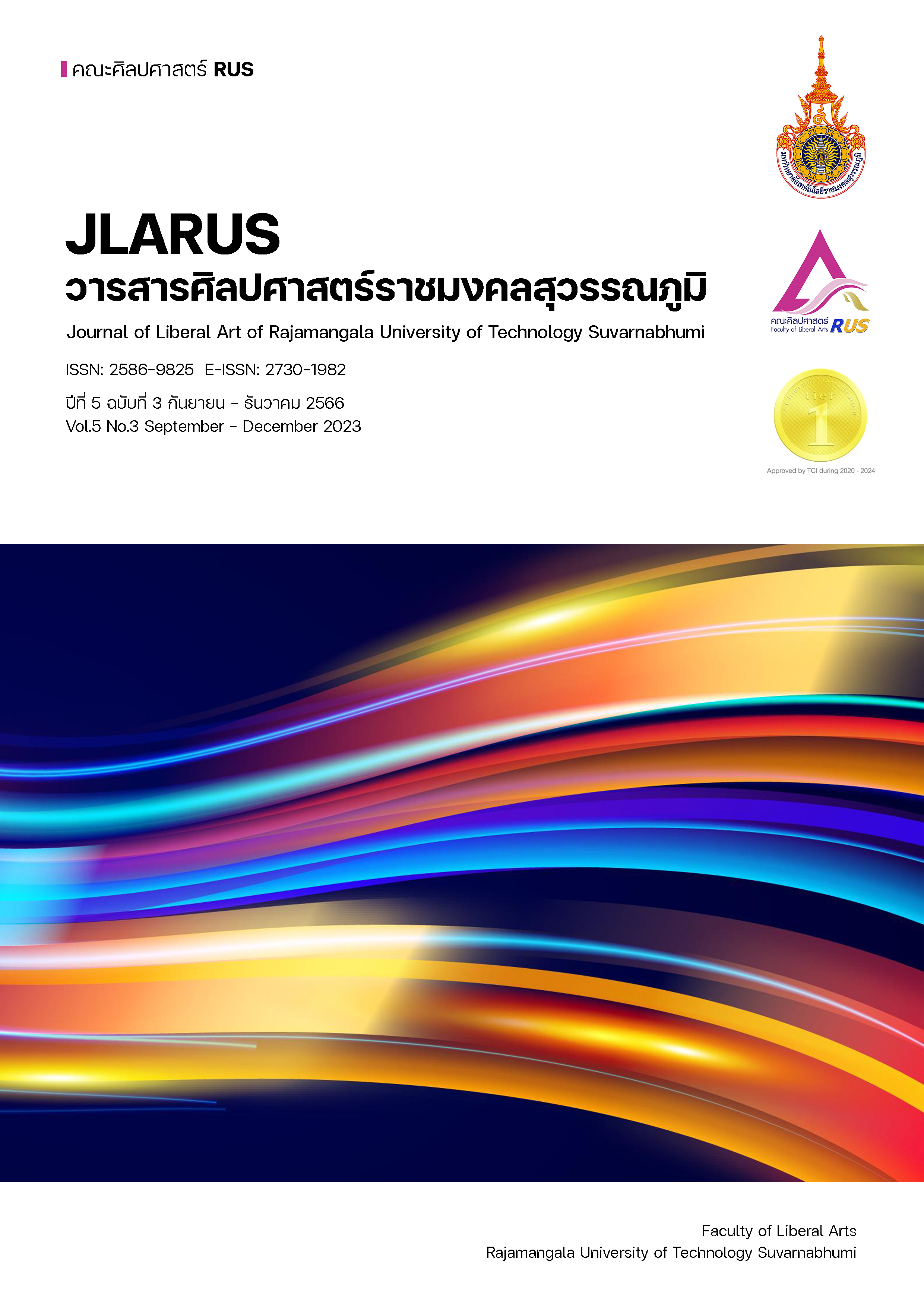CULTURAL PERSPECTIVE REFLECTED THROUGH THE USE OF LANGUAGE IN THE NOVEL BUPPESANNIVAS
Main Article Content
Abstract
This research has the objective to analyze the cultural perspective reflected in the use of language in the novel Buppesannivas authored by Rom Phaeng or Chanyawee Sompreeda's pseudonym, which sets the theme and determines the characters to use the interesting and remarkable language. Due to the differences in languages between the language in the past and the present that readers must understand, the researchers therefore studied and analyzed the use of language by Thai people in the drama Buppesannivas in order to know the various cultures that appear in the story. The research is done by studying the criteria for classifying culture, collecting theories and research related to the use of language that reflects culture, collecting lectures and conversations of the full version of period drama Buppesannivas , analyzing strategies according to the criteria that have been set as well as the culture of language use of Thai people by using the Nida’s criteria for categorizing cultures namely: ecological culture, material culture, social culture, religious culture, and linguistic culture. The results were summarized and presented through descriptive analysis.
The research results found that the use of language in the novel Buppesannivas reflects a cultural perspective in various respects which are prominent in order respectively as follows; First of all, social culture in terms of social structure and social class; followed by religious culture which is the belief in the principles of Buddhism, belief in the law of karma and reincarnation, beliefs in astrology and magic spells and the last one is language culture in the use of images, the use of expressions, and the construction of words which is the use of slang words and transliterated words.
Article Details

This work is licensed under a Creative Commons Attribution-NonCommercial-NoDerivatives 4.0 International License.
References
กฤติญา กวีจารุกรณ์. (2563). บทความการนำเสนองานวิจัยเปรียบเทียบบทละครโทรทัศน์กับการผลิตสู่การออกอากาศ กรณีศึกษา: ละครโทรทัศน์เรื่อง บุพเพสันนิวาส. สืบค้น 27 เมษายน 2563. จาก http://research.bkkthon.ac.th/.
ชนกพร อังศุวิริยะ. (2559). ภาษากับสังคม. กรุงเทพมหานคร: โอเดียนสโตร์.
ดิษยทรรศน์ ศรีบุญเรือง และสุทธภา อินทรศิลป์. (2562). ภาพความเป็นชายจากการสร้างตัวละครเอกฝ่ายชายในนวนิยายเรื่องบุพเพสันนิวาส ของรอมแพง. วารสารบัณฑิตศึกษามหาจุฬาขอนแก่น, 6(1), 431-445.
เทวากร คำสัตย์. (2563). บุพเพสันนิวาส: ภาพสะท้อนด้านการถ่ายทอดข้อมูลทางวัฒนธรรม. วารสารมนุษยศาสตร์และสังคมศาสตร์ มหาวิทยาลัยนครพนม, 10(1), 126-134.
บัวผัน สุพรรณยศ. (2562). เพลงพื้นบ้านภาคกลาง ศิลปะการสอนเพศศึกษาแบบชาวบ้านไทย. วารสารมนุษยศาสตร์วิชาการ, 26(2), 152-200.
ประชุมพงศาวดาร เล่ม 16 (ประชุมพงศาวดาร ภาคที่ 27). (2507). กรุงเทพมหานคร: องค์การค้าของคุรุสภา.
พัน จันทนุมาศ. (2479). ประชุมพงศาวดาร ภาคที่ 64 พงศาวดารกรุงศรีอยุธยา ฉบับพันจันทนุมาศ (เจิม). พระนครกรุงศรีอยุธยา: โสภณพิพรรฒธนากร.
พูนพิศมัย ดิศกุล, ม.จ. หญิง. (2504). พิธีของทุกคน. กรุงเทพมหานคร: เขษมบรรณกิจ.
รอมแพง. (2561). บุพเพสันนิวาส. (พิมพ์ครั้งที่ 94). กรุงเทพมหานคร: แฮปปี้บานานา.
ราชบัณฑิตยสถาน. (2556). พจนานุกรมฉบับราชบัณฑิตยสถาน พ.ศ. 2554. กรุงเทพมหานคร: นานมีบุ๊คส์พับลิเคชั่นส์.
ราชบัณฑิตยสภา. (2551). เต้นแร้งเต้นกา. สืบค้น 27 เมษายน 2563. จาก http://legacy.orst.go.th/ ?knowledges=เต้นแร้งเต้นกา-๓-มิถุนายน.
ราชบัณฑิตยสภา. (2551). หัวเรือใหญ่. สืบค้น 27 เมษายน 2563. จาก http://legacy.orst.go.th/ ?knowledges=หัวเรือใหญ่-๒-กุมภาพันธ์.
ล้อม เพ็งแก้ว. (2548). เสนาะเสน่ห์สำนวนไทย. กรุงเทพมหานคร: สำนักพิมพ์มติชน.
ลักขณา รุ่งโรจน์. (2565). กลวิธีการแสดงความเห็นโต้แย้งในละครย้อนยุค เรื่อง บุพเพสันนิวาส. วารสารศิลปศาสตร์ราชมงคล, 4(2), 347-359.
วรุณญา อัจฉริยบดี. (2561). การตีความฉาก “ตลาด” ในฐานะพื้นที่จากนวนิยายอิงประวัติศาสตร์เรื่องบุพเพสันนิวาส. ในการประชุมวิชาการบัณฑิตศึกษาระดับชาติ สรรพศาสตร์ สรรพศิลป์ ประจำปี 2561, 202-217. มหาวิทยาลัยธรรมศาสตร์ ท่าพระจันทร์.
ศิริญญา สุจินตวงษ์. (2554). 100 เรื่องล้ำสมัยในสยาม. กรุงเทพมหานคร: อมรินทร์.
ศิริพร ปัญญาเมธีกุล. (2561). ภาษาเพื่อการสื่อสารข้ามวัฒนธรรม. (พิมพ์ครั้งที่ 4). กรุงเทพมหานคร: บจก.พริ้นท์คอร์เนอร์.
สมโภชน์ อัคคะทวีวัฒน์. (2547). สาระน่ารู้ปลาน้ำจืดไทย. กรุงเทพมหานคร: องค์การค้าของคุรุสภา.
สรรัตน์ จิรบวรวิสุทธิ์. (2562). จินตนาการเกี่ยวกับกรุงศรีอยุธยา “ครั้งบ้านเมืองดี” ในละครโทรทัศน์เรื่อง “บุพเพสันนิวาส”. วารสารนิเทศสยามปริทัศน์, 18(24), 8-12
สรรัตน์ จิรบวรวิสุทธิ์. (2562). สุนทรียทัศน์ของผู้ชมชาวจีนที่มีต่อละครโทรทัศน์เรื่อง บุพเพสันนิวาส. วารสารศาสตร์, 12(3), 50-79.
สุพัตรา สุภาพ. (2540). สังคมวิทยา. กรุงเทพมหานคร: ไทยวัฒนาพานิช.
สุพิศวง ธรรมพันทา. (2532). พื้นฐานวัฒนธรรมไทย. กรุงเทพมหานคร: ดีดีบุคสโตร์.
สุมาลี พลขุนทรัพย์. (2560). ลีลาภาษาของรอมแพงในนวนิยายข้ามภพข้ามชาติเรื่อง “บุพเพสันนิวาส”.International Conference on Humanities & Social Sciences 2017. 13(1), 2194-2209.
Clark-Kent. (2559). ปากหอยปากปู. สืบค้น 27 เมษายน 2563. จาก https://www.oknation.net/ post/detail/634f7dac859f46d6cec923d1.
Hymes, D. (1964). Language in Culture and Society. New York: Harper&Row.


